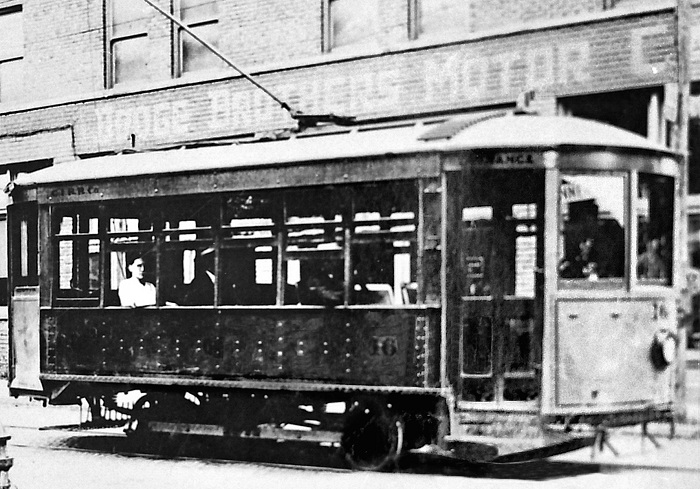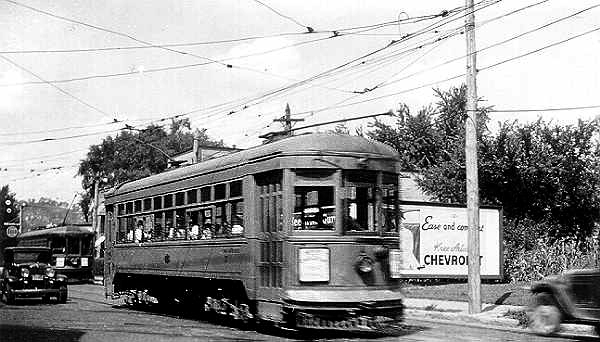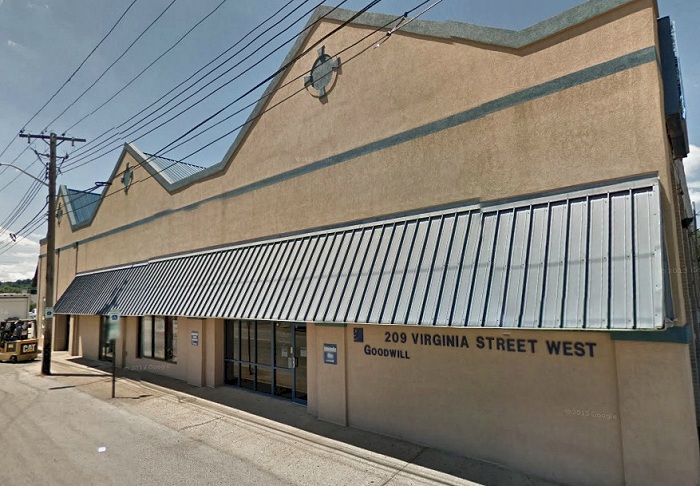CHARLESTON STREETCARS & BUSES

You
may recognize this building. If you dont, the answer is at the
bottom of this page. This was the Street Car Barn on Virginia
Street West. This photo was taken in 1920.
HERE IS SOME OF THE ROLLING STOCK OF
THE STREET CAR COMPANY.
|

This
was the first: The Charleston Traction Companywas started in 1888
with two horse drawn cars. Later they were replaced with electric cars
as seen in the photo.
|

Notice
the Dodge Brothers building in the background. Thay were located
at Virginia & Truslow Streets

Most of the rest of these photos
were taken in front of the Streetcar Barn



Some cars have CIRRCo on
them, which stands for "Charleston Interurban Railroad Company"


Notice the
"Cow-catcher" on the front.




The Patrick and Stockton Street Trolley
parked on Virginia Street


Maintenance
Vehicle



This is the Power Station on the West Side of the Elk
River. This later would become the "Boys Club"

Same building from the opposite side, now being used by the
city in this 70s photo.
The sign on the right side of the buildings says "Boys Athletic Club".
I remember it very well.
At
a receiver’s sale in 1935, the property passed into the hands of the
Charleston Transit Company, which converted the entire operation to
buses on June 29, 1939.
|
You used
Tokens to ride the bus back then. I still have two of mine.

The Street Car Barn would
later become the Bus Barn for the Charleston Transit Co.
They moved to Stockton Street in 1950.
Of course, there were a few fender benders,,,, |

You're
looking at Virginia Street just off Morris. Mountain State
Hospital is to the right of the bus. The year is 1937 and it seems that
a one Miss Margaret Kearse, daughter of T.L Kearse, owner
of the Kearse Theater was driving south on Morris St, when she
hit a city bus traveling East on Virginia. The bus then struck a
parked car, sending it into a power pole. The bus continued on and
struck 2 more poles and finally hit the new car you see in the photo,
owned by the Ruby Motor Company. Seventeen fire alarm boxes were
knocked out of service along with the trolly wires.
|
 Taken around 1910
Taken around 1910






That same year, McMillion
Motors moved into the barn for 1 year

This sign was uncovered
in 2015 during Goodwill's remodeling
 Here is the Streetcar Barn today.
Goodwill Industries on Virginia Street
Here is the Streetcar Barn today.
Goodwill Industries on Virginia Street
You
will see Streetcars in action all though this website in various years.
Look for them.
|
Streetcar
History
The
city of Charleston in Kanawha County (West Virginia) had a trolley
operation from 1888 to 1939. The network consisted of city lines in
Charleston and overland lines through North Charleston to Dunbar, South
Charleston to St. Albans and Marmet to Cabin Creek Junction. Charleston
Street Railway .
In 1888, the Charleston Street Railway Co.
opened the first horse-drawn trolley that ran as a ring around the city
center, along Kanawha Street (now Kanawha Boulevard), Brooks Street,
Dryden Street (now Smith Street), and Capitol Street. A second line was
opened shortly afterwards from Capitol Street and Virginia Street,
Central Avenue and 4th Avenue to Patrick Street in West Charleston. It
was eventually extended from Capitol Street to the east by Washington
Street to the then city limits on Bradford Street. This was the
complete trolley network. Charleston Traction Company .
In 1898,
W. Hazard acquired the railway and re-established it as the Charleston
Traction Co. In the following years, the new owner electrified the
routes. Kanawha Valley Traction Company .
In 1902, the owner
changed again and the company was now called Kanawha Valley Traction
Co. In 1903, the railway company took out the rails from Kanawha Street
and led the ring line instead by Quarrier Street. Also on Virginia
Street, tracks were laid between Capitol Street and Brooks Street.
Eastward, the railway was extended on both Virginia Street and
Washington Street through a resettled residential area to and on Duffy
Street (now the Capitol Complex), creating a new ring line. A link
through Ruffner Avenue between Washington and Virginia Street was also
opened during this time. In addition, a stretch was built from Dryden
Street over the Elk River, on Bigley Avenue, Charleston Street (now
Washington Street) and Tennessee Avenue to Virginia Street. At the
corner of Virginia Street and Tennessee Avenue was the new depot of the
railway.
In 1907, Edgewood Park, a recreational center with a
zoo and amusement facilities operated by the trolley company, was built
in the north of the city on a hill. A new trolley route from Charleston
Street / Tennessee Avenue connected this park to Charleston Street and
Edgewood Drive to the city. In the same year, the Chesapeake and Ohio
Railroad, whose railway ran south of the Kanawha River, a connecting
track to the north of the river route of the Kanawha and Michigan
Railway planned, together with the trolley operation, the Kanawha
Bridge and Terminal Co. was founded. It built a single track railway
bridge over the river, whose track would also be used by the trolleys.
The steel river bridge was connected at both ends by ramps in the form
of an elongated wooden trestle, at the respective end of the trolley
line branches off the railway track. A new link to the north end of the
bridge construction originated from Central Avenue through Russell
Street and Seventh Street.
The new line to South Charleston was
opened in 1908. Within the city, there were now three ring lines, which
were driven only in the specified direction: Inner Ring: Capitol Street
- Quarrier Street - Brooks Street - Smith Street - Capitol Street
Central Ring: Capitol Street - Virginia Street - Ruffner Avenue -
Washington Street - Capitol Street Outer Ring: Capitol Street -
Washington Street - Duffy Avenue - Virginia Street - Capitol Street In
addition, trains from Capitol Street on Virginia Street and Tennessee
Avenue to Edgewood Park, on Drydon Street, Tennessee Avenue and Central
Avenue to West Charleston (Patrick Street) and on the Virginia Street
and the Kanawha Bridge to South Charleston. Charleston Interurban
Railroad.
In 1910, the Charleston Interurban Railroad Co. was
founded with the aim to build overland routes. It leased the Kanawha
Valley Traction Company and now ran operations on the trolley. First,
in 1912, the route was extended to South Charleston via Spring Hill and
Jefferson along MacCorkle Avenue to St. Albans.
Also in 1912 was
another amusement park, Luna Park in West Charleston began operation,
was built on Central Avenue off of Park Avenue to the level of Grant
Street, a branch line. The company then built another stretch on
Summers Street, where the terminal was just off Virginia Street, by
State Street (now Lee Street), Truslow Street (now built over), Lovell
Street (now Washington Street), Charleston Street , Pennsylvania
Avenue, Roane Street, Charleston Street (now Washington Street),
Stockton Street and 7th Avenue through North Charleston to Dunbar.
In
1915, the Kanawha City Bridge went into operation as the second river
bridge with a trolley track. The route on eastern Washington Street was
extended from the previous terminal on Duffy Avenue through Washington
Street and over the bridge, which was located at the northern extension
of 34th Street, to Kanawha City. There, the route led through Central
Avenue (now MacCorkle Avenue) and further along its extension through
Marmet, Chesapeake and Chelyan to Cabin Creek Junction. It was
partially completed by 1916. In the 1920s, the route was laid down by
Pennsylvania Avenue and Roane Street and the trains to Dunbar now drove
directly through the Charleston Street on the track, on which
previously drove only the line to Edgewood Park (now Cato Park). The
central departure point of all lines was then at Virginia Avenue,
corner of Alderson Street (now Laidley Street). Even today, all city
bus lines depart Charleston on Laidley Street.
First bus traffic
… The Midland Trail Transit Co., which was partly owned by the
Charleston Interurban Railroad, began in 1925 with the regular bus
service in Charleston. The first line led to Hillsdale from Virginia
Street via Summers Street, Truslow, Lovell, Charleston Street, Bigley
Avenue, Cora Street, Crescent Road, Westmoreland Drive, O'Dell Avenue,
Garland Avenue and back to Bigley Avenue to Charleston. In the same
year, the second line from Capitol Street on Lee Street, Broad Street,
Smith Street, Morris Street, Piedmont Road to Wertz Avenue, and a third
line from Capitol Street on the South Side Bridge to South Hills was
opened. The latter line led in South Hills on the Bridge Avenue (now
Bridge Road), Myrtle Avenue, Oakmont Road, Walnut Road, Bridge Avenue,
Oakwood Drive (now Oakwood Road), South Avenue (now MacCorkle Avenue)
and Ferry Street. When the State Capitol was relocated from Capitol
Street east to Washington Street in 1932, the bus company routed its
line to Piedmont Road on the way back to Charleston through Wertz
Avenue, Washington Street, California Avenue, McClung Street, Jackson
Street, Ruffner Avenue, Lewis Street, Morris Street and Capitol Street
to connect the two government complexes. Charleston Transit Company.
The
Charleston Interurban Railroad went bankrupt in 1933 and was re-erected
in 1935 as Charleston Transit Co. It also took over the bus operation.
The company was now anxious to get rid of the unprofitable rail traffic
and laid to June 29, 1939 all routes still. Buses took over the traffic
and in the same year, intercity bus lines to Montgomery, St. Albans and
Nitro went into operation, in the following years, the entire county
was opened by bus lines. In 1971, the Kanawha Valley Regional
Transportation Authority (KRT) took over the operation, which still
operates numerous bus lines in Kanawha County. Today remains of the
former trolley operation only the Kanawha Bridge, which is also
decommissioned for rail traffic, as well as the building of the former
depot, which is now used by an industrial plant. The buses were kept
here until May 1950, until the new, still used today bus depot at 4th
Avenue / Stockton Street was opened
|
Vintage photos By Daniel
Davidson & Dick Johnson.
©
COPYRIGHT
All
content including articles and photos on this website Copyright 2013 by
J. Waters. All images on this website are used with
permission or
outright ownership of J. Waters.
All newspaper articles
are courtesy of the Charleston Gazette or Daily Mail for the express
use of the author. You do NOT have permission to use any image, article
or material without permission from the author. You do NOT have permission to pull
photos from this website and post them to Facebook or any other
website. Any
material used without permission will be subject to creative copyright
laws.
Back to index
|



























